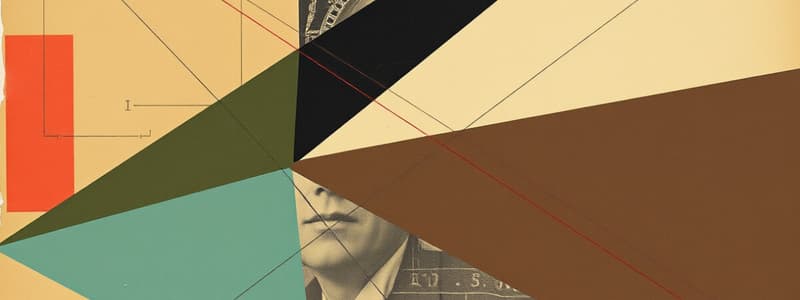Podcast
Questions and Answers
What does the Midpoint Theorem state?
What does the Midpoint Theorem state?
- Vertical angles are congruent.
- If two lines are perpendicular, they form congruent adjacent angles.
- If point 'M' is the midpoint of AB, then AM = 0.5AB and MB = 0.5AB. (correct)
- If BX is the bisector of ∠ABC, then m∠ABX = 0.5*m∠ABC and m∠XBC = 0.5*m∠ABC.
What does the Angle Bisector Theorem imply?
What does the Angle Bisector Theorem imply?
If BX is the bisector of ∠ABC, then m∠ABX = 0.5m∠ABC and m∠XBC = 0.5m∠ABC.
Vertical angles are congruent.
Vertical angles are congruent.
True (A)
What can be concluded from the Perpendicular Theorem?
What can be concluded from the Perpendicular Theorem?
If two adjacent acute angles are formed by perpendicular exterior sides, those angles are _____
If two adjacent acute angles are formed by perpendicular exterior sides, those angles are _____
What is the Triangle Sum Theorem?
What is the Triangle Sum Theorem?
What does the Hypotenuse Leg Theorem state?
What does the Hypotenuse Leg Theorem state?
The diagonals of a parallelogram bisect each other.
The diagonals of a parallelogram bisect each other.
What does the Opposite Sides of Parallelograms are Congruent Theorem state?
What does the Opposite Sides of Parallelograms are Congruent Theorem state?
What is the requirement for a quadrilateral to be a rectangle according to the Rectangle Theorem?
What is the requirement for a quadrilateral to be a rectangle according to the Rectangle Theorem?
Flashcards are hidden until you start studying
Study Notes
Midpoint Theorem
- If point "M" is the midpoint of line segment AB, then segments AM and MB are each equal to half the length of AB.
Angle Bisector Theorem
- If line BX bisects angle ∠ABC, then angles ∠ABX and ∠XBC each measure half of angle ∠ABC.
Vertical Angle Theorem
- Vertical angles, formed when two lines intersect, are always congruent.
Perpendicular Theorem
- When two lines are perpendicular, they create two pairs of congruent adjacent angles.
Adjacent Acute Angles Theorem
- If the exterior sides of two adjacent acute angles are perpendicular, the two angles are complementary.
Supplements of Congruent Angles Theorem
- If two angles are each supplements of congruent angles, then the two angles must also be congruent.
Complements of Congruent Angles Theorem
- If two angles are complements of congruent angles, then those two angles are congruent as well.
Parallel Planes Theorem
- When two parallel planes are intersected by a third plane, the lines of intersection are also parallel.
Perpendicular Transversal Theorem
- If a transversal line is perpendicular to one of two parallel lines, it is also perpendicular to the other.
Alternate-Interior Angles Theorem
- When a transversal cuts two parallel lines, the alternate-interior angles formed are congruent.
Alternate-Exterior Angles Theorem
- Similar to alternate-interior angles, the alternate-exterior angles formed by a transversal cutting parallel lines are congruent.
Same-Side Interior Angles Theorem
- For parallel lines cut by a transversal, the same-side interior angles are supplementary.
Parallel Theorem
- If two lines are both parallel to a third line, then all three lines are mutually parallel.
Triangle Sum Theorem
- The sum of the angles in any triangle is always 180 degrees.
Remote Interior Angles Theorem
- The measure of an exterior angle in a triangle equals the sum of the measures of the two non-adjacent (remote) interior angles.
Corresponding Parts of Congruent Triangles Theorem (CPCTC)
- Congruent triangles have congruent corresponding parts, including angles and sides.
Isosceles Triangle Theorem
- In an isosceles triangle, angles opposite the two equal sides are congruent.
Triangle Inequality Theorem
- The sum of any two sides of a triangle must be greater than the length of the third side.
Hypotenuse Leg Theorem
- For right triangles, if the hypotenuse and one leg of one triangle are congruent to the hypotenuse and leg of another, the triangles are congruent.
Opposite Sides of Parallelograms are Congruent Theorem
- In a parallelogram, both pairs of opposite sides are congruent.
Opposite Angles of Parallelograms are Congruent Theorem
- In a parallelogram, both pairs of opposite angles are congruent.
Diagonals of Parallelograms Bisect Each Other Theorem
- The diagonals of a parallelogram bisect each other.
One Pair of Opposite Sides are Congruent and Parallel Theorem
- If one pair of opposite sides in a quadrilateral are both congruent and parallel, then the quadrilateral is a parallelogram.
Rectangle Theorem
- If one angle in a parallelogram is a right angle, then the parallelogram is classified as a rectangle.
Studying That Suits You
Use AI to generate personalized quizzes and flashcards to suit your learning preferences.




